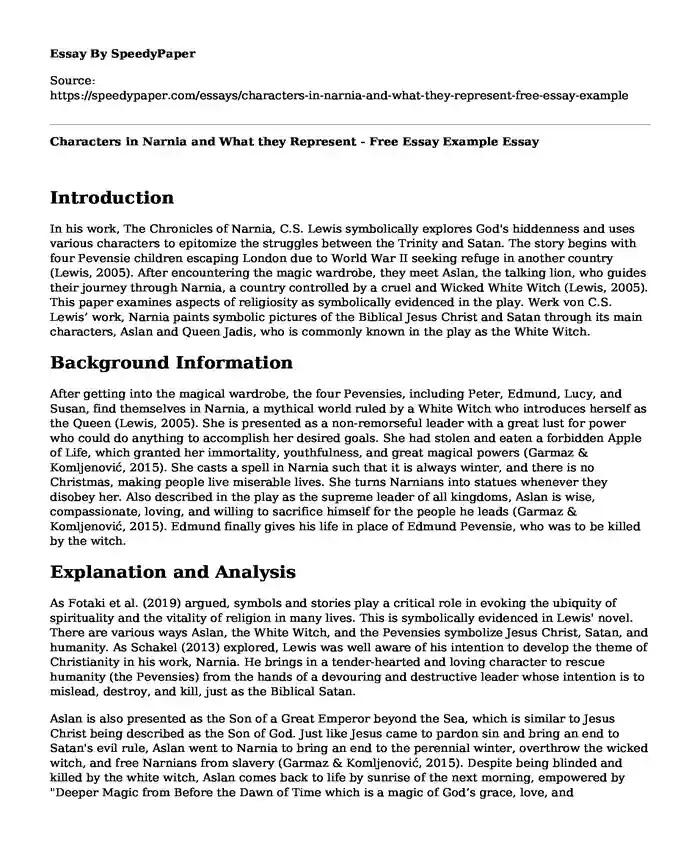
| Type of paper: | Essay |
| Categories: | Religion Bible Character analysis |
| Pages: | 3 |
| Wordcount: | 801 words |
Introduction
In his work, The Chronicles of Narnia, C.S. Lewis symbolically explores God's hiddenness and uses various characters to epitomize the struggles between the Trinity and Satan. The story begins with four Pevensie children escaping London due to World War II seeking refuge in another country (Lewis, 2005). After encountering the magic wardrobe, they meet Aslan, the talking lion, who guides their journey through Narnia, a country controlled by a cruel and Wicked White Witch (Lewis, 2005). This paper examines aspects of religiosity as symbolically evidenced in the play. Werk von C.S. Lewis’ work, Narnia paints symbolic pictures of the Biblical Jesus Christ and Satan through its main characters, Aslan and Queen Jadis, who is commonly known in the play as the White Witch.
Background Information
After getting into the magical wardrobe, the four Pevensies, including Peter, Edmund, Lucy, and Susan, find themselves in Narnia, a mythical world ruled by a White Witch who introduces herself as the Queen (Lewis, 2005). She is presented as a non-remorseful leader with a great lust for power who could do anything to accomplish her desired goals. She had stolen and eaten a forbidden Apple of Life, which granted her immortality, youthfulness, and great magical powers (Garmaz & Komljenovic, 2015). She casts a spell in Narnia such that it is always winter, and there is no Christmas, making people live miserable lives. She turns Narnians into statues whenever they disobey her. Also described in the play as the supreme leader of all kingdoms, Aslan is wise, compassionate, loving, and willing to sacrifice himself for the people he leads (Garmaz & Komljenovic, 2015). Edmund finally gives his life in place of Edmund Pevensie, who was to be killed by the witch.
Explanation and Analysis
As Fotaki et al. (2019) argued, symbols and stories play a critical role in evoking the ubiquity of spirituality and the vitality of religion in many lives. This is symbolically evidenced in Lewis' novel. There are various ways Aslan, the White Witch, and the Pevensies symbolize Jesus Christ, Satan, and humanity. As Schakel (2013) explored, Lewis was well aware of his intention to develop the theme of Christianity in his work, Narnia. He brings in a tender-hearted and loving character to rescue humanity (the Pevensies) from the hands of a devouring and destructive leader whose intention is to mislead, destroy, and kill, just as the Biblical Satan.
Aslan is also presented as the Son of a Great Emperor beyond the Sea, which is similar to Jesus Christ being described as the Son of God. Just like Jesus came to pardon sin and bring an end to Satan's evil rule, Aslan went to Narnia to bring an end to the perennial winter, overthrow the wicked witch, and free Narnians from slavery (Garmaz & Komljenovic, 2015). Despite being blinded and killed by the white witch, Aslan comes back to life by sunrise of the next morning, empowered by "Deeper Magic from Before the Dawn of Time which is a magic of God’s grace, love, and forgiveness” (Schalek, 2013, p. 8). Such an encounter mirrors Jesus’ death and resurrection even though he resurrected after three days and not one day as expressed in the play. Schakel (2013) and Garmaz and Komljenovic (2015) developed similar arguments in examining the hidden image of Jesus Christ in Lewis's play.
Conclusion
The pictures of Jesus Christ and Satan are evident through C.S. Lewis's novel, the Chronicles of Narnia. Like Satan's desire to deceive and destroy, the White Witch is a selfish ruler who finds contentment in misleading others and killing them whenever they disobey her. Lust, slavery, and destruction guide her leadership. Just like Jesus came as a ransom to deliver his people from the bondage of sin and satanic ways, Aslan is sacrificed but resurrects by the next day, overthrowing the witch and restoring order, love, and happiness in Narnia. However, it attracts more attention as to why the story does not exactly match the biblical narration of Jesus' life if Lewis intended to accurately depict the mysteries of Jesus Christ. Such inconsistencies call for further analysis of the play.
References
Fotaki, M., Altman, Y., & Koning, J. (2019). Spirituality, symbolism, and storytelling in twenty-first-century organizations: Understanding and addressing the crisis of imagination. Organization Studies, 41(1), 7-30. https://doi.org/10.1177/0170840619875782
Garmaz, J., & Komljenovic, P. (2015). Jesus in Narnia. Narrative Katechese im Werk von C.S. Lewis. The Person and the Challenges. The Journal of Theology, Education, Canon Law, and Social Studies Inspired by Pope John Paul II, 5(1), 41. https://doi.org/10.15633/pch.926
Lewis, C. S. (2005). The Lion, the Witch, and the Wardrobe (adult). Zondervan.
Schakel, P. J. (2013). Hidden images of Christ in the fiction of C. S. Lewis. Studies in the Literary Imagination, 46(2), 1-18. https://doi.org/10.1353/sli.2013.0010
Cite this page
Characters in Narnia and What they Represent - Free Essay Example. (2023, Dec 20). Retrieved from https://speedypaper.net/essays/characters-in-narnia-and-what-they-represent-free-essay-example
Request Removal
If you are the original author of this essay and no longer wish to have it published on the SpeedyPaper website, please click below to request its removal:
- Indentured Servitude and Colonial Labor - AP US History Essay Sample
- Free Essay on the Effects of Love on the Characters in A Midsummer Night's Dream
- Caring for People God's Way: Christian Counseling Essay Example
- Personal Reflection Essay Sample on the Article: Commodified Agents and Empowered Girl
- Essay Sample Dedicated to Constantine the Great
- Creative Writing Essay Example: The Werewolf Experience
- Free Essay Example. Nathaniel Hawthorne Biography
Popular categories




